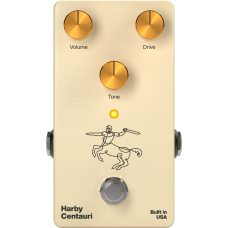Harby Centauri
Modeled directly after its predecessor’s circuit board, the Klon Centaur, Harby Centauri is built using the highest-quality components to give you that rich, clear Centaur sound without the Centaur price tag.
In 1994, Bill Finnegan made a legendary contribution to the guitar industry: the Klon Centaur overdrive stomp pedal. With a clear, well-articulated sound that’s free from synthetic, solid-state distortion and unnecessary heaviness, the Centaur became a favorite among guitarists everywhere, and its popularity hasn’t declined since.
Not everyone could get their hands on one, though. Finnegan only built 8,000 units, and these days, they command prices in the neighborhood of $7,000. So naturally, many guitarists opened up Centaurs to study the circuit board schematics in order to copy them and build their own. For years, these guitarists were thwarted by a thick layer of epoxy coating every Centaur circuit board. It wasn’t until 2009 that Martin Chittum finally managed to remove the resin from a Centaur and the schematics were revealed.
Like our fellow pedal junkies, we decided to recreate the Centaur to take up less space on your stomp board without sacrificing the original’s clarity and sweetness. Using the original circuit board design and parts that Finnegan himself relied on, the Harby Centauri can be used on any pedal board for a huge range of applications. Use it on its own to juice up your output, get a clean boost with the drive knob turned all the way down, or combine it with fuzz and distortion pedals to add a slightly thicker character to their heavy grit. And with its buffered bypass, the Centauri, like the original Klon Centaur, is never truly off—its mellow, clear tone can always be relied on in the studio and on-stage.
All that said, we’d never claim that the Centauri is a perfect sonic match to any Klon. Finnegan himself said that the sound varied from Centaur to Centaur, due to the nature of the clipping diodes he used. We’ve simply attempted to replicate the Centaur’s quality and richness through a faithful reconstruction according to Finnegan’s specifications. The results speak for themselves.

